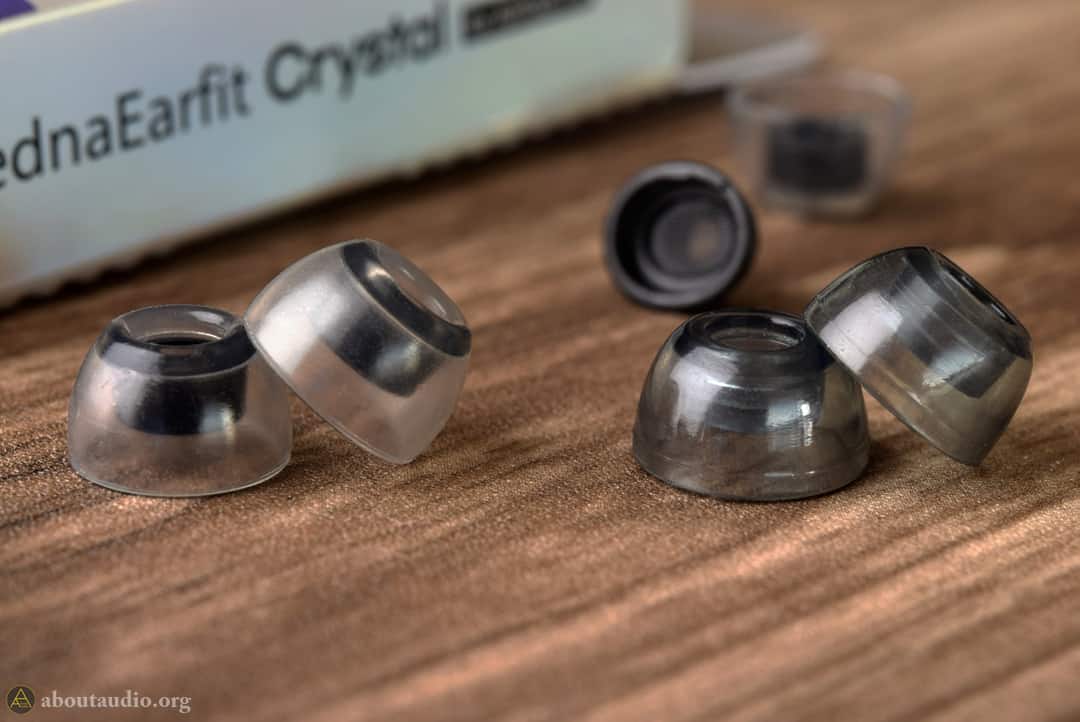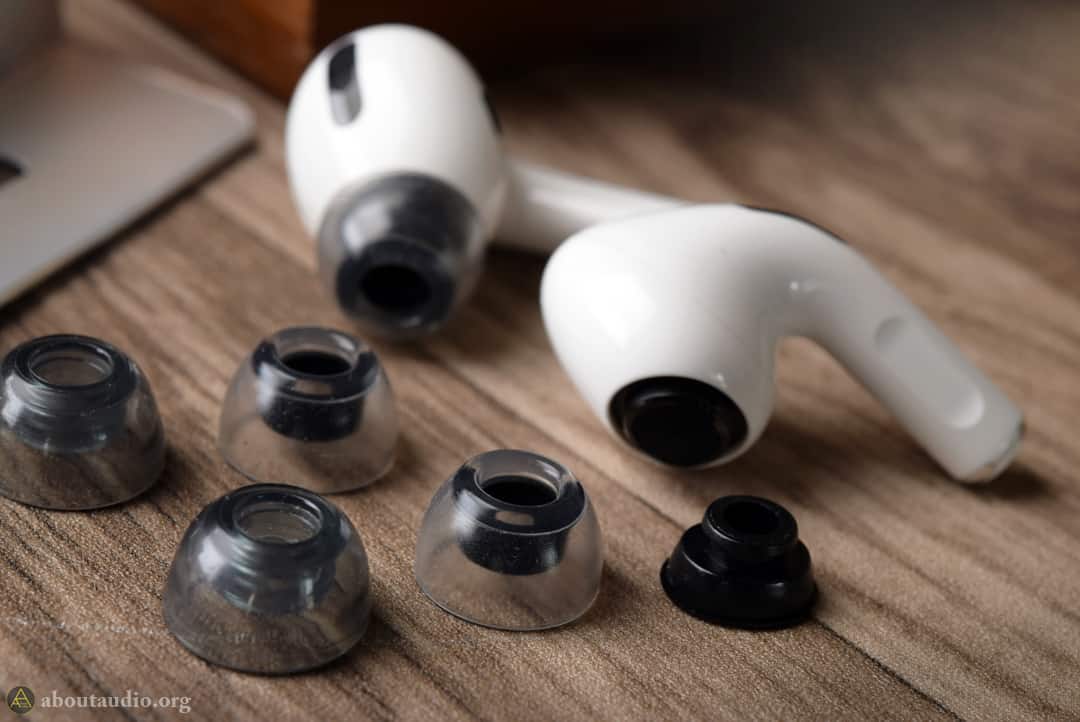 AZLA Crystal Review: Kinda Xelastec but everything easier
AZLA Crystal Review: Kinda Xelastec but everything easier
It is no surprise to most audiophiles by now that eartips matter big time when talking about earphones. Even for those who weren’t particularly passionate about sound quality and audio gears, simply swapping to an aftermarket eartip for whatever reason would be a good enough opportunity to realize the sound difference.
We previously did a review for AZLA Xelastec, eartips made of TPE which certainly impressed us in many ways. While Xelastec seemed to be just perfect, it still had its own drawbacks. Living up to the demands, as well as providing an alternative solution, AZLA once again released their latest eartip series – Sedna Earfit Crystal. Today’s review will be aimed at the Apple AirPods Pro variation. Now – let’s see what is different, why is different, and how is it different from Xelastec and the Apple stock eartips.
 Foam, TPE, and but now once again… LSR.
Foam, TPE, and but now once again… LSR.
Though if we vaguely categorize them, types of eartips could be divided into three groups; silicone, foam, a hybrid of both, and lastly – TPE (AZLA Xelastec). As introduced before, AZLA is a Korean IEM/eartip manufacturer that has been producing a variety of products including AZLA IEMs (Horizon, Orta, Zwei, etc.) and the Sedna Earfit series. Xelastec still holds the “flagship” of all AZLA eartip products, though Sedna Earfit Crystal, the latest variation of its series, comes neck and neck with Xelastec.
p.s. As a side note, be aware that there are parts that overlap with our previous Xelastec review. Feel free to jump to your needed topic, though I suggest going through all as such topics are likely backed up with comparisons, if necessary.
 Why were foam tips popular in the first place?
Why were foam tips popular in the first place?
Before talking about the other features of Xelastec, let us first consider why so many people have been using foam tips. Foam tips are contractible that allows users to insert them into the ears and let the foam expand accordingly to their shapes. Since that, foam tips make it much easier for users to achieve higher isolation and better comfort. Just as the name says – it is a foam version of an eartip that is “customizable” to every user since its cushion-like texture.
Drawbacks of foams
There are some side effects once using foam tips, though. First, foam tips deteriorate fast. They would soon begin to diminish in contractibility and isolation. They are fragile, so they will start to show splits and cracks after some usage or eventually break down. Lastly, and above all, the foam itself serves as an extra layer of a damper to the earphone nozzle. This causes the sound to be duller, warmer, looser, and increased in bass quantity. Of course, it would be unfair to necessarily call such changes to be bad (since some may actually prefer their IEMs to gain those effects), though they are undoubtedly signs of degraded sound quality caused by the foam.
 So we have Xelastec. Why not just that?
So we have Xelastec. Why not just that?
Now might be a good time to ask: why another variation of eartip materials other than TPE (Xelastec)? Well, that is because Xelastec has some clear drawbacks behind its unprecedented clarity and fixation power. First, Xelastec is a serious dust collector. It’s good in collecting dust just as a piece of tape, so you get the idea. Although they provide immense fixation power and security to the fit, the dust problem appears to be inevitable due to its sticky texture. A quick rinse with tap water would do the work but it’s still a hassle. The second drawback of Xelastec (or TPE) is the deformation. Xelastec’s thermoplasticity allowed the shape to transform according to the outer surface (which would be your ear canals). However, if the eartips stay squished or pressed against another object for too long, the shape would stay deformed even without the thermoplasticity kicking into action.
 Left is after the hot water trick. Right is the default state.
Left is after the hot water trick. Right is the default state.
TPE deformation
Don’t get me wrong though, they are still fully functional like they’ve never been deformed before. Though it’s still unpleasant to have a squashed pair of eartips to be installed to your earphones. Another scenario could be that the nozzle of the earphone is noticeably wider than Xelastec’s. Having the Xelastec installed on a wide nozzle could enlarge the stem, causing the eartips to slip out easier on thinner nozzles. As described on Xelastec review, both scenarios could be solved by following through the ‘hot water’ trick described by AZLA – but the size of the eartip would mildly increase (really, really mildly). At the end of the day, you just have to keep them carefully stored to prevent them from collecting dust and
 The Pitch – Sedna Earfit Crystal and LSR
The Pitch – Sedna Earfit Crystal and LSR
Let us first define the difference between Sedna Earfit Crystal (Crystal in short) and Xelastec in terms of material. Crystal is made of medical-grade Liquid Silicone Rubber (LSR) and Xelastec is made of Thermoplastic Elastomer (TPE). Both are made of elastomers – but TPE is capable of reprocessing its default shape or form while LSR cannot.
Crystal vs. Xelastec
So does that mean Crystal won’t have the grippiness and that “auto-fitting” experience as Xelastec had? That is not the case, ironically. Crystal is almost as grippy as Xelastec but not to the point of calling it sticky. The texture on Crystal feels a lot smoother than Xelastec and collects noticeably less dust. The fixation power also comes close to Xelastec. Most importantly, the shape does not collect ongoing deformation while being as compliable as Xelastec. It’s quite surprising to see how comfortable these are without thermoplasticity.
Keep in mind that these impressions (at least for comfort and fit) are currently relevant for the AirPods Pro version as I’m yet to experience the normal IEM version of Crystal. But so far, I’m positive that the normal IEM version would be just as comfortable and compliable. Speaking of isolation, Xelastec seems to be a slightly better job due to its unprecedented grippiness.
 Crystal for Apple AirPods Pro
Crystal for Apple AirPods Pro
Sedna Earfit Crystal is available in three variations – normal version (meant for general IEMs), TWS version, and AirPods Pro version. As AZLA did with Xelastec, they’ve made another eartip dedicated for the AirPods Pro. The stem is now shorter to make them perfectly fit into the Airpods Pro case without a problem. Airpods Pro also requires an additional eartip mounting adapter (since the original eartips are simply made in one unified chunk), so AZLA made one – but with superior construction and material. The mounting adapters are urethane-coated for stronger noise isolation and minimizing bass loss.
 The Fit / Isolation
The Fit / Isolation
While ordinary silicone eartips have a rather smooth surface, Crystal is quite clingy in its texture as mentioned. The grippiness is similar to the latest SpinFit silicone but less wobbly. The eartips would snug right into the ears, unlike Xelastec which required a minor effort. The firmness of the fit is simply top-notch as the earpieces don’t seem to shake one bit while I shake my head or do workouts. Inside the stem have deep grooves that secure Crystal to keep them intact with the earpieces.
The stock eartips from Airpods Pro were rather flimsy and gives an ambiguous firmness, although they did a mediocre job in keeping the earpieces intact. As Xelastec did, Crystal shows a significant difference when it comes to fitting as I could sense the eartips grasping onto my ear canals. Needless to say, firm fit means effectively filling up the ear canal, and effectively filling up the ear canal means effective isolation. These do provide better isolation than the wobbly stock eartips and bring up the ANC performance as well.
 Sound comparisons – Crystal vs. Stock AirPods Pro eartips
Sound comparisons – Crystal vs. Stock AirPods Pro eartips
I’ve always mentioned “Sonic Linearity” when dealing with AZLA products since this is one of their core design factor – to keep the sonic path straight as possible. Well, this was indeed applied to Xelastec before and on Crystal too. Crystal brings evident and pleasant improvements to the sound. It’s a clear improvement rather than a ‘change’ as Crystal keeps the style of the sound as original as possible.
Alongside, the sound transmission feels to be faster and expeditious; I said feel because this effect may be limited to aural perception rather than technically speaking. Bass gets tighter and punchier, all while having loose reverbs or boominess neatly organized. Along with that, the bass grooves get thicker both in color and thickness. The results? A cleaner, tighter bass response that does not degrade the bass quantity but instead brings them out even deeper. Simply speaking, it removes unwanted elements that hold back the bass performance and adds up the necessities to make the bass sound even better. The bass slams are cleaner and stronger, overall making the bass response to gain changes that are nothing but ideal. Both Crystal and Xelastec overall show similar contrasts when matched against the stock Apple eartips, though there are still clear differences once we make the comparison between these two elastomer eartips.
 Sound comparisons – Crystal vs. Xelastec
Sound comparisons – Crystal vs. Xelastec
Let us put these two elastomer eartips up to the comparison. Xelastec draws a more v-shaped sound signature, bringing crisper, airier, and brighter sound. The bass quantity is pretty much the same on both eartips but with a bit of a cooler tone on Xelastec while a warmer tone is present on Crystal. The bass grooves are mildly clearer and cleaner on Xelastec. But then again, the vocal density, moistness, and fullness of the body are greater on Crystal. This is pretty much a tie and would come down to personal preference – Xelastec for analyticity and Crystal for originality or musicality.
 Verdicts
Verdicts
AZLA came up with another sleek output that enriches the user experience in every way. From an audiophile perspective, Crystal is charismatic in the sense that it pursues sonic linearity same as Xelastec yet with different sonic characteristics. From an average, EDC user’s perspective, Crystal’s grippy yet sleeker texture guarantees a firm, stable fit without causing possibly excessive grip (such as eartips falling into the ears when pulling out) or collecting a bunch of dust. Not to forget mention that Crystal is more resistant to shape distortion, overall allowing to use the earphones more light-heartedly. If you are looking for an alternative eartip for your AirPods Pro, I would suggest that Crystal and Xelastec would be hands down the best two choices you could possibly make. If you prefer a smoother sound with easier usability, Crystal will be the very answer.
RELATED REVIEWS
AZLA – Horizon AZLA – Orta AZLA – Azel AZLA – Zwei
AZLA – Xelastec (original version)
AZLA – Xelastec (for Apple AirPods Pro)
Thanks to AZLA for providing Sedna Earfit Crystal in exchange for an honest impression/feedback.
I am not affiliated with AZLA and none of my words were modded or asked to be changed.



